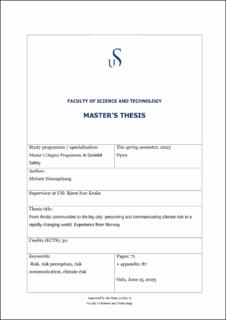| dc.description.abstract | The risk of climate change encompasses an entirely new approach to risk that has never been experienced before; its consequences do not only affect and threaten the people living on the planet now but also future generations. At the forefront of climate change is Longyearbyen, an Arctic settlement on the Norwegian archipelago Svalbard which is viewed as "a living lab" for climate change as it is warming much faster than the global average. Further south, on the northernmost part of the Norwegian mainland, is Nordkapp. A small municipality that, in recent years, has had to take preventive measures to prevent avalanches. In the very south of Norway is Norway's capital, Oslo, which is regarded as more protected against the most harmful effects of climate change.
This thesis researched how the public authorities in Longyearbyen, Nordkapp, and Oslo perceive and communicate climate risks. In a world that is getting warmer and where urbanization is expected to increase, public authorities will be a bridge builder between experts and the public. Empirics from qualitative document analysis and semi-structured interviews with three informants from Longyearbyen, Nordkapp and Oslo were discussed using theories on risk, risk perception and risk communication.
This study found that climate change's impact on the overall risk affects risk communication strategies and risk perception. In Longyearbyen and Nordkapp, societies this study found climate risks to manifest objectively more significant, prioritized short-term climate disaster handling. In contrast, in Oslo, which is less exposed to the harmful effects of climate change, issues related to climate adaptation were given more awareness. However, the correlation between climate risk and public authority action can be based on more than just risk perception but also resources and priorities. The study also highlights the importance of local knowledge in assessing climate change risks, as experts alone do not provide a comprehensive understanding of how climate risks affect Longyearbyen, Nordkapp and Oslo. | |
